Chemical Coordination and Integration NCERT
Quiz Summary
0 of 45 Questions completed
Questions:
Information
You have already completed the quiz before. Hence you can not start it again.
Quiz is loading…
You must sign in or sign up to start the quiz.
You must first complete the following:
Results
Results
0 of 45 Questions answered correctly
Your time:
Time has elapsed
You have reached 0 of 0 point(s), (0)
Earned Point(s): 0 of 0, (0)
0 Essay(s) Pending (Possible Point(s): 0)
Categories
- Not categorized 0%
- 1
- 2
- 3
- 4
- 5
- 6
- 7
- 8
- 9
- 10
- 11
- 12
- 13
- 14
- 15
- 16
- 17
- 18
- 19
- 20
- 21
- 22
- 23
- 24
- 25
- 26
- 27
- 28
- 29
- 30
- 31
- 32
- 33
- 34
- 35
- 36
- 37
- 38
- 39
- 40
- 41
- 42
- 43
- 44
- 45
- Current
- Review
- Answered
- Correct
- Incorrect
-
Question 1 of 45
1. Question
1 point(s)Consider the two statements:
Assertion (A): Apart from the organised endocrine glands, hormones are secreted by other parts of the human body as well.
Reason (R): Hormone is any non-nutrient chemical which acts as intercellular messenger and is produced in trace amounts.CorrectIncorrectHint
(a)
-
Question 2 of 45
2. Question
1 point(s)Somatostatin from the hypothalamus:
CorrectIncorrectHint
(d)
-
Question 3 of 45
3. Question
1 point(s)Which of the following is an antagonistic pair of hormones?
CorrectIncorrectHint
(c)
-
Question 4 of 45
4. Question
1 point(s)Identify the incorrectly matched pair:
\(
\begin{array}{|l|l|l|}
\hline \text { 1. } & \begin{array}{l}
\text { Hyposecretion of growth hormone in } \\
\text { childhood }
\end{array} & \text { Dwarfism } \\
\hline \text { 2. } & \begin{array}{l}
\text { Hyposecretion of growth hormone in } \\
\text { adulthood }
\end{array} & \text { Cretinism } \\
\hline \text { 3. } & \begin{array}{l}
\text { Hypersecretion of growth hormone in } \\
\text { childhood }
\end{array} & \text { Gigantism } \\
\hline \text { 4. } & \begin{array}{l}
\text { Hypersecretion of growth hormone in } \\
\text { adulthood }
\end{array} & \text { Acromegaly } \\
\hline
\end{array}
\)CorrectIncorrectHint
(b)
The incorrectly matched pair is:
2. Hyposecretion of growth hormone in adulthood — Cretinism
Explanation:
- Cretinism is caused by hyposecretion of thyroid hormone (not growth hormone), and it occurs in infancy or early childhood.
- Hyposecretion of growth hormone in adulthood does not cause cretinism; instead, it may lead to reduced muscle mass and energy, but no specific named disorder like in childhood.
-
Question 5 of 45
5. Question
1 point(s)Pars distalis is:
CorrectIncorrectHint
(c)
-
Question 6 of 45
6. Question
1 point(s)Read the given statements and choose the correct
option.
A: Neural system provides point-to-point coordination among organs.
B: The response of chemical coordination is quick but short-livedCorrectIncorrectHint
(c)
Statement B:
“The response of chemical coordination is quick but short-lived.”
❌ Incorrect- Chemical coordination (via hormones) is generally slow in onset but long-lasting in effect.
- It’s the neural system that produces a quick and short-lived response.
-
Question 7 of 45
7. Question
1 point(s)The function of aldosterone is mainly:
CorrectIncorrectHint
(a)
-
Question 8 of 45
8. Question
1 point(s)In males, androgens like testosterone secreted by Leydig cells in testes do not:
CorrectIncorrectHint
(d)
-
❌ Produce catabolic effects on protein and carbohydrate metabolism – This is incorrect because:
- Testosterone is anabolic, not catabolic.
- It promotes protein synthesis, muscle growth, and increases bone density.
- It enhances nitrogen retention and has a positive effect on muscle mass.
- Catabolic hormones (like cortisol) break down proteins — testosterone does the opposite.
-
Question 9 of 45
9. Question
1 point(s)Observe the following figures. Identify A to D:-
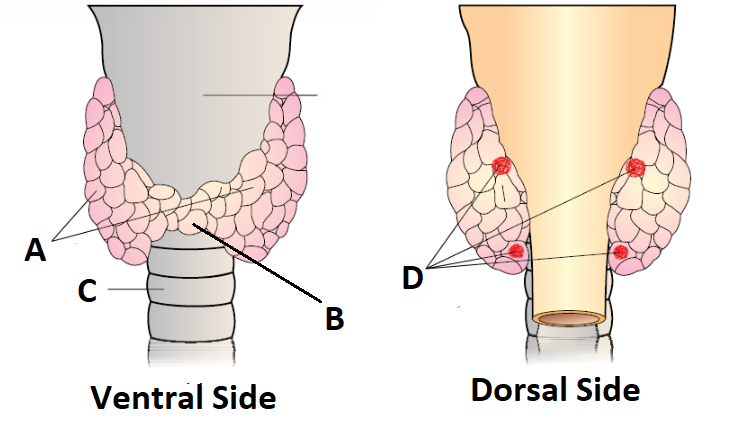 CorrectIncorrect
CorrectIncorrectHint
(b)
-
Question 10 of 45
10. Question
1 point(s)Go through the below diagrammatic representation of the mechanism of action for 2 categories of hormones. In which
of the following options correct answers for blanks A to I are indicated.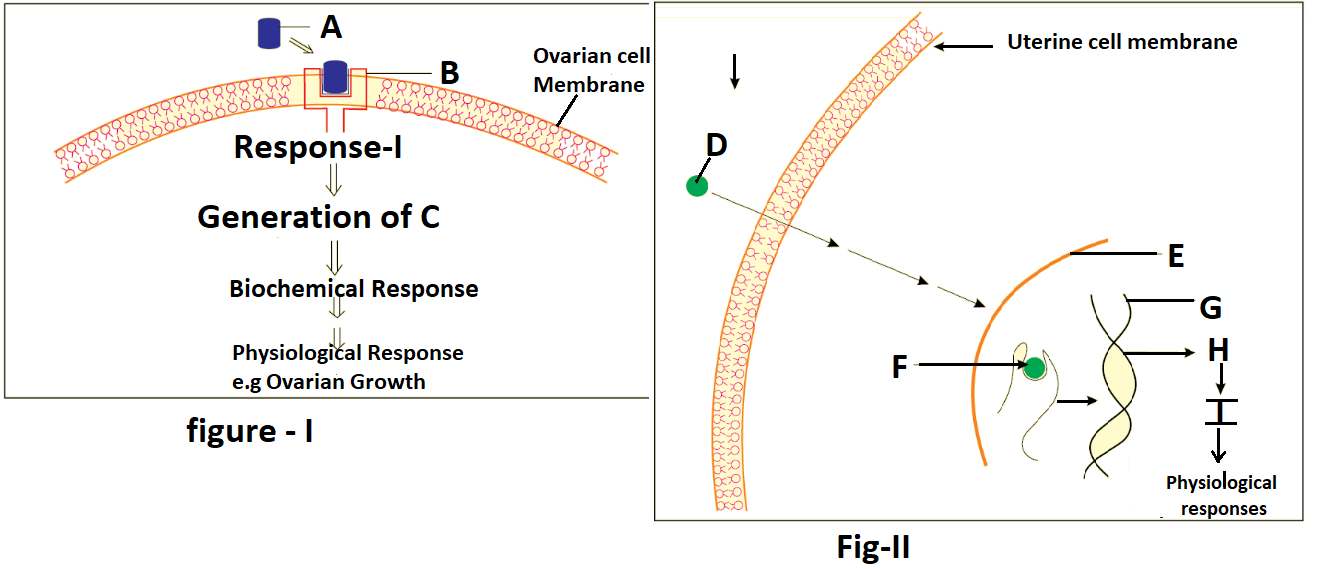 CorrectIncorrect
CorrectIncorrectHint
(b)
-
Question 11 of 45
11. Question
1 point(s)Observe the following diagrams and identify alphabetized items:-
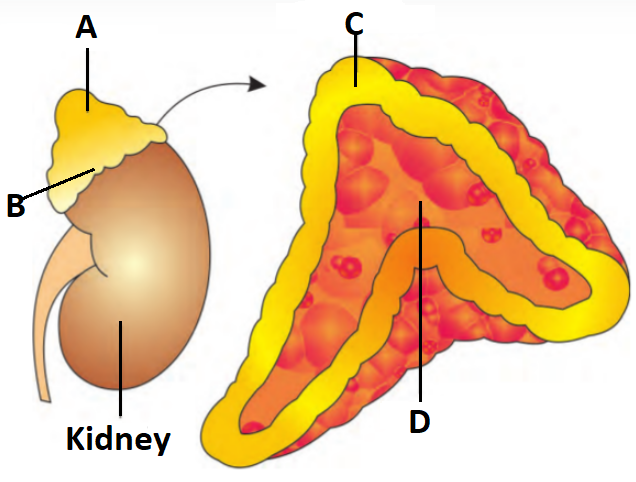 CorrectIncorrect
CorrectIncorrectHint
(a)
-
Question 12 of 45
12. Question
1 point(s)What will be true for A, B, C and D as shown in the given figure?
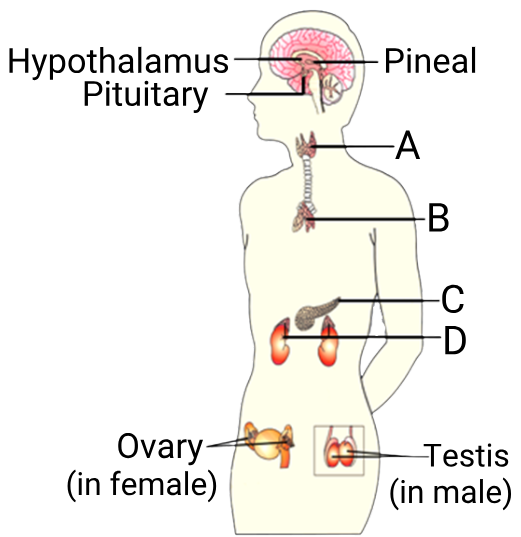
I. The glands located in the region A play a very important role in calcium homeostasis.
II. The gland B increases in size from puberty to adulthood and then decreases in size in old age.
III. C is both an endocrine and an exocrine gland.
IV. D is kidney and does not produce any hormone.CorrectIncorrectHint
(a)
II. The gland B increases in size from puberty to adulthood and then decreases in size in old age.
❌ Incorrect – The thymus is largest in childhood and shrinks after puberty, undergoing involution.IV. D is kidney and does not produce any hormone.
❌ Incorrect – D is adrenal gland, not kidney, and it does produce hormones (e.g., adrenaline, cortisol, aldosterone).
Even kidneys produce hormones like erythropoietin and renin, so even if D was kidney, this would still be wrong. -
Question 13 of 45
13. Question
1 point(s)Identify the correct statement regarding the pineal gland or the hormone secreted by it:
CorrectIncorrectHint
(c)
1. ❌ “The gland is situated on the ventral side of the forebrain”
- Incorrect. The pineal gland is located on the dorsal side of the forebrain, near the epithalamus (above the thalamus).
2.❌ “The hormone secreted by the gland is called as melanin”
- Incorrect. The hormone is melatonin, not melanin (which is a skin pigment produced by melanocytes).
4.
❌ “The hormone decreases immunity”
-
Incorrect. Melatonin actually has immunomodulatory effects and can enhance immunity, especially antioxidant and anti-inflammatory roles.
-
Question 14 of 45
14. Question
1 point(s)Identify the incorrectly matched pair:
\(
\begin{array}{|l|l|l|}
\hline \text { 1. } & \text { MSH } & \text { Regulation of pigmentation of skin } \\
\hline \text { 2. } & \text { Oxytocin } & \text { Parturition and milk ejection } \\
\hline \text { 3. } & \text { ADH } & \text { Increases water loss through urine } \\
\hline \text { 4. } & \text { Thymosins } & \text { Adaptive [acquired] immunity } \\
\hline
\end{array}
\)CorrectIncorrectHint
(c)
Decrease water loss
-
Question 15 of 45
15. Question
1 point(s)Consider the functions given:
I. Stimulation of synthesis of androgens
II. Regulation of spermatogenesis
III. Induction of ovulation
IV. Maintenance of corpus luteumCorrectIncorrectHint
(b)
Regulation of spermatogenesis
❌ Incorrect – Spermatogenesis is mainly regulated by FSH (Follicle Stimulating Hormone), which acts on Sertoli cells. LH plays only an indirect role via testosterone. -
Question 16 of 45
16. Question
1 point(s)Identify the incorrect statement regarding thyroid gland:
CorrectIncorrectHint
(d)
All hormones secreted by thyroid are iodothyronines
❌ Incorrect – While T3 and T4 are iodothyronines, the thyroid also secretes calcitonin, which is not an iodothyronine.-
Calcitonin is secreted by parafollicular (C cells) of the thyroid and plays a role in calcium homeostasis.
-
Question 17 of 45
17. Question
1 point(s)Consider the following regarding the actions of steroidal hormones produced by human ovary:
I. Estrogen is responsible for the development and maintenance of secondary sexual characters in females
II. Progesterone is a pregnancy hormone
III. Estrogen regulates female sexual behavior
IV. Progesterone stimulates the formation of alveoli in mammary glands
Select correct statements from above statementsCorrectIncorrectHint
(d)
-
Question 18 of 45
18. Question
1 point(s)The hormones of ‘flight or fight‘ response:
CorrectIncorrectHint
(b)
-
Question 19 of 45
19. Question
1 point(s)All the following statements regarding parathyroid hormone are correct except:
CorrectIncorrectHint
(b)
❌ False – PTH is not regulated by any tropic hormone from the anterior pituitary.
Instead, its secretion is directly regulated by blood calcium levels via negative feedback. When blood calcium is low, PTH secretion increases -
Question 20 of 45
20. Question
1 point(s)Match each item in COLUMN I [Hormone] with one in COLUMN II [Function] and select your answer from the codes given:
\(
\begin{array}{|l|l|}
\hline \begin{array}{l}
\text { COLUMN I } \\
\end{array} & \text { COLUMN II } \\
\hline \text { A. ADH } & \begin{array}{l}
\text { a. Makes collecting duct permeable to water } \\
\text { and urea }
\end{array} \\
\hline \text { B. PTH } & \text { b. Stimulates osteoclasts } \\
\hline \text { C. LH } & \begin{array}{l}
\text { c. Rupture of Graafian follicle leading to } \\
\text { ovulation }
\end{array} \\
\hline \text { D. ANF } & \text { d. Causes vasodilation } \\
\hline
\end{array}
\)
Codes:
\(
\begin{array}{|l|l|l|l|l|}
\hline & \text { A } & \text { B } & \text { C } & \text { D } \\
\hline 1 . & \text { a } & \text { b } & \text { c } & \text { d } \\
\hline 2 . & \text { a } & \text { b } & \text { d } & \text { c } \\
\hline 3 . & \text { b } & \text { a } & \text { d } & \text { c } \\
\hline 4 . & \text { b } & \text { a } & \text { c } & \text { d } \\
\hline
\end{array}
\)CorrectIncorrectHint
(a)
-
Question 21 of 45
21. Question
1 point(s)All the following regarding parathyroid glands are true except:
CorrectIncorrectHint
(c)
The statement that is false regarding parathyroid glands is: They secrete parathyroid hormone and calcitonin; only parathyroid hormone is secreted by the parathyroid glands, while calcitonin is secreted by the thyroid gland
-
Question 22 of 45
22. Question
1 point(s)Identify the hormone:
I. It favours glycogenesis.
II. It favours fat synthesis and deposition.
III. It favours protein anabolism.CorrectIncorrectHint
(b)
-
Question 23 of 45
23. Question
1 point(s)Which of the following is not a feature characteristic of the anterior pituitary?
CorrectIncorrectHint
(c)
The hypothalamohypophyseal tract (nerve fibers) transports oxytocin and ADH from the hypothalamus to the posterior pituitary (neurohypophysis)
In contrast, the anterior pituitary (adenohypophysis) receives hormonal signals via blood vessels, not via neural tract terminal
-
Question 24 of 45
24. Question
1 point(s)Consider the given two statements:
Assertion: Vasopressin is also called as Anti Diuretic Hormone [ADH].
Reason: It is a vasoconstrictor.CorrectIncorrectHint
(b)
-
Question 25 of 45
25. Question
1 point(s)Identify the correct statement from the following:
Statement I: Prolactin causes the milk ejection from the mammary glands.
Statement II: Oxytocin regulates the formation of milk in the mammary glands.
Statement III: FSH stimulates growth and development of ovarian follicles in females.
Statement IV: MSH acts on melanocytes and regulates the secretion of melatonin.CorrectIncorrectHint
(a)
1 ❌ This is incorrect. Prolactin primarily stimulates milk production (lactogenesis), while oxytocin is responsible for the milk ejection reflex (let‑down
2 This is also incorrect. Oxytocin triggers milk ejection, not the actual production or formation of milk
4 ❌ Incorrect. MSH (Melanocyte Stimulating Hormone) targets melanocytes to increase melanin synthesis, not melatonin secretion
-
Question 26 of 45
26. Question
1 point(s)The pineal gland:
I: helps in maintaining the normal rhythms of sleepwakefulness cycle and body temperature.
II. influences metabolism, pigmentation and the menstrual cycle.CorrectIncorrectHint
(c)
-
Question 27 of 45
27. Question
1 point(s)Consider the given two statements:
I: PTH is a hypercalcaemic hormone.
II: PTH stimulates reabsorption of calcium by the renal tubules.CorrectIncorrectHint
(a)
-
Question 28 of 45
28. Question
1 point(s)Identify the correct statement from the following:
I: The adrenal cortical hormones are commonly called as corticoids.
II: Cortisol is the main glucocorticoid and aldosterone the main mineralocorticoid in our body.
III: Small amounts of androgenic steroids are also secreted by the adrenal cortex.CorrectIncorrectHint
(c)
-
Question 29 of 45
29. Question
1 point(s)Identify the incorrect statement:
I. Ovary is the primary female sex organ and testis is the primary male sex organ.
II. Oestrogen is synthesised by the growing ovarian follicles and progesterone is secreted by the corpus luteum mainly.CorrectIncorrectHint
(d)
BOTH ARE CORRECT
-
Question 30 of 45
30. Question
1 point(s)Consider the given two statements:
Assertion: Insulin causes hypoglycemia.
Reason: As a result of action of insulin especially on adipocytes and hepatocytes, there is a rapid movement of glucose from blood to these cells.CorrectIncorrectHint
(a)
-
Question 31 of 45
31. Question
1 point(s)Match each item in Column I with one in Column II and select the correct match from the codes given:
\[
\begin{array}{|l|l|l|p{6cm}|}
\hline
& \textbf{COLUMN I} & & \textbf{COLUMN II} \\ \hline
A & \text{Cholecystokinin (CCK)} & R &
Acts on exocrine pancreas and gall bladder\newline
stimulates secretion of pancreatic enzymes and bile juice \\ \hline
B & \text{Secretin} & Q &
Acts on exocrine pancreas and stimulates\newline
secretion of water and bicarbonate ions \\ \hline
C & \text{Gastrin} & P &
Stimulates secretion of HCl and pepsinogen\newline
by gastric glands \\ \hline
D & \text{Gastric inhibitory peptide (GIP)} & S &
Inhibits gastric secretion and motility\newline
and has no effect on exocrine pancreas \\ \hline
\end{array}
\]Codes:
\(
\begin{array}{|l|l|l|l|l|}
\hline & \text { A } & \text { B } & \text { C } & \text { D } \\
\hline 1 . & \text { Q } & \text { P } & \text { R } & \text { S } \\
\hline 2 . & \text { R } & \text { Q } & \text { S } & \text { P } \\
\hline 3 . & \text { R } & \text { Q } & \text { P } & \text { S } \\
\hline 4 . & \text { P } & \text { Q } & \text { R } & \text { S } \\
\hline
\end{array}
\)CorrectIncorrectHint
(c)
-
Question 32 of 45
32. Question
1 point(s)Consider the given two statements:
Assertion: Chronic kidney disease can cause anaemia.
Reason: Kidneys produces a peptide hormone, erythropoietin, which stimulates red blood cell production (erythropoiesis) in the bone marrowCorrectIncorrectHint
(a)
-
Question 33 of 45
33. Question
1 point(s)Match each item in COLUMN I [Hormone] with one in COLUMN II [Chemical class] and select your answer from the codes given:
\(
\begin{array}{|l|l|l|l|}
\hline & \text { COLUMN I } & & \text { COLUMN II } \\
\hline \text { A. } & \text { ACTH } & \text { a. } & \text { Peptide } \\
\hline \text { B. } & \text { Estradiol } & \text { b. } & \text { Steroid } \\
\hline \text { C. } & \text { Thyroxine } & \text { c. } & \text { Amino-acid derived } \\
\hline \text { D. } & \text { Epinephrine } & \text { d. } & \text { Iodothyronine } \\
\hline
\end{array}
\)
Codes:
\(
\begin{array}{|l|l|l|l|l|}
\hline & \text { A } & \text { B } & \text { C } & \text { D } \\
\hline 1 . & \text { a } & \text { b } & \text { c } & \text { d } \\
\hline 2 . & \text { a } & \text { b } & \text { d } & \text { c } \\
\hline 3 . & \text { b } & \text { a } & \text { d } & \text { c } \\
\hline 4 . & \text { b } & \text { a } & \text { c } & \text { d } \\
\hline
\end{array}
\)CorrectIncorrectHint
(b)
-
Question 34 of 45
34. Question
1 point(s)Consider the given two statements:
Statement I: Hormones act on all the cells in the human body.
Statement II: Hormones are intercellular chemical messengers transported by blood throughout the body.CorrectIncorrectHint
(d)
“Hormones act on all the cells in the human body.”
This is false. Although circulating hormones reach nearly all cells through blood, they only affect target cells—those that express the specific receptors required to respond -
Question 35 of 45
35. Question
1 point(s)How many of the following hormones are antagonistic to insulin wrt glucose level in blood?
(a) GH, Thyroxine
(b) Glucocorticoids
(c) Somatostatin
(d) Adrenaline, nor-adrenaline
Choose the correct option.CorrectIncorrectHint
(d)
C:- Somatostatin
-
Inhibits both insulin and glucagon. Regulatory, not directly antagonistic to insulin. ❌
-
Question 36 of 45
36. Question
1 point(s)Choose the incorrect statement w.r.t. pancreas:-
CorrectIncorrectHint
(c)
❌ Incorrect
- Insulin increases the uptake and utilisation of glucose by hepatocytes and adipocytes, not decreases it.
- It lowers blood glucose by promoting glucose storage and usage, not blocking it
-
Question 37 of 45
37. Question
1 point(s)The given figure shows the mechanism of action of FSH on its target cells.
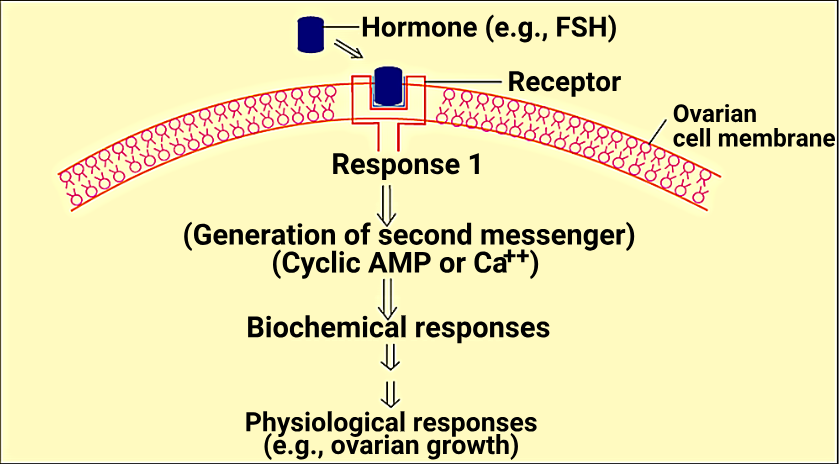
I. FSH is hydrophilic and hence cannot enter the cell and therefore acts via a second messenger.
II. The second messenger will cause physiological responses after binding to a receptor present in the nucleus of the cells and then influencing the level of gene expression in the target cell.CorrectIncorrectHint
(a)
-
Question 38 of 45
38. Question
1 point(s)A health disorder that results from the deficiency of thyroxine in adults and characterized by
(i) a low metabolic rate
(ii) increase in body weight
(iii) tendency to retain water in tissues isCorrectIncorrectHint
(a)
-
Question 39 of 45
39. Question
1 point(s)Metabolic functions of insulin include:
I. Retards the uptake, use and utilization of glucose by body cells
II. Promotes the uptake of amino acids by body cells
III. Promotes the storage of fat and prevents lipolysisCorrectIncorrectHint
(c)
❌ Statement I: “Retards the uptake, use and utilization of glucose by body cells”
-
This is incorrect.
-
Insulin actually promotes the uptake and utilization of glucose by body cells, especially muscle and adipose tissue, thereby reducing blood glucose levels.
-
Question 40 of 45
40. Question
1 point(s)All of the following statements are correct for parathyroid hormone except
CorrectIncorrectHint
(d)
(4) Increases excretion of calcium and phosphate in urine
-
Incorrect.
-
PTH decreases Ca²⁺ excretion (promotes reabsorption).
-
It increases phosphate excretion to prevent calcium-phosphate complex formation, maintaining free calcium levels in blood.
-
-
Question 41 of 45
41. Question
1 point(s)How many organs given below in the box are considered as organized endocrine glands?
\(
\begin{array}{|l|}
\hline \text { Stomach, Intestine, Pituitary gland, Liver, } \\
\text { Kidney, Thyroid gland, Heart } \\
\hline
\end{array}
\)CorrectIncorrectHint
(c)
✅ Correctly Classified “Organized Endocrine Glands”:
- Pituitary gland
- Thyroid gland
-
Question 42 of 45
42. Question
1 point(s)Select the incorrect statement.
CorrectIncorrectHint
(a)
Hormones are intercellular messengers,
-
Question 43 of 45
43. Question
1 point(s)Identify A, B, C and D in the following given figure and choose the option which correctly represents them.

\(
\begin{array}{|l|l|l|l|l|}
\hline
& \text{A} & \text{B} & \text{C} & \text{D} \\
\hline
(1) & \begin{array}{l} \text{Anterior} \\ \text{pituitary} \end{array}
& \begin{array}{l} \text{Portal} \\ \text{vein} \end{array}
& \text{Hypothalamus}
& \begin{array}{l} \text{Hypothalamic} \\ \text{neurons} \end{array} \\
\hline
(2) & \begin{array}{l} \text{Posterior} \\ \text{pituitary} \end{array}
& \begin{array}{l} \text{Portal} \\ \text{circulation} \end{array}
& \begin{array}{l} \text{Hypothalamic} \\ \text{neurons} \end{array}
& \text{Hypothalamus} \\
\hline
(3) & \begin{array}{l} \text{Anterior} \\ \text{pituitary} \end{array}
& \begin{array}{l} \text{Portal} \\ \text{circulation} \end{array}
& \text{Hypothalamus}
& \text{Midbrain} \\
\hline
(4) & \begin{array}{l} \text{Posterior} \\ \text{pituitary} \end{array}
& \begin{array}{l} \text{Portal} \\ \text{circulation} \end{array}
& \begin{array}{l} \text{Hypothalamic} \\ \text{Neurons} \end{array}
& \text{Midbrain} \\
\hline
\end{array}
\)CorrectIncorrectHint
(b)
-
Question 44 of 45
44. Question
1 point(s)Identify correct match:-
\(
\begin{array}{|l|l|l|l|}
\hline
& \text{Source gland} & \text{Hormone} & \text{Function} \\
\hline
(1) & \text{Thyroid gland} & \text{Thyrocalcitonin} & \text{Regulates calcium level in blood} \\
\hline
(2) & \text{Parathyroid gland} & \text{Parathormone} & \text{Regulates BMR} \\
\hline
(3) & \text{Posterior pituitary} & \text{Vasopressin} & \text{Water and electrolyte reabsorption from renal tubule} \\
\hline
(4) & \text{Pineal gland} & \text{Melanin} & \text{Regulates diurnal rhythm} \\
\hline
\end{array}
\)CorrectIncorrectHint
(a)
-
Question 45 of 45
45. Question
1 point(s)How many hormones given in the box below are peptide in nature?
\(
\boxed{
\begin{array}{ccccccc}
\text{CCK,} & \text{GIP,} & \text{Gastrin,} & \text{Secretin} & \text{ANF,} & \text{PTH,} & \text{T}_4
\end{array}
}
\)CorrectIncorrectHint
(b)
Only T₄ (Thyroxine) is not a peptide, but rather an iodinated amino acid derivative